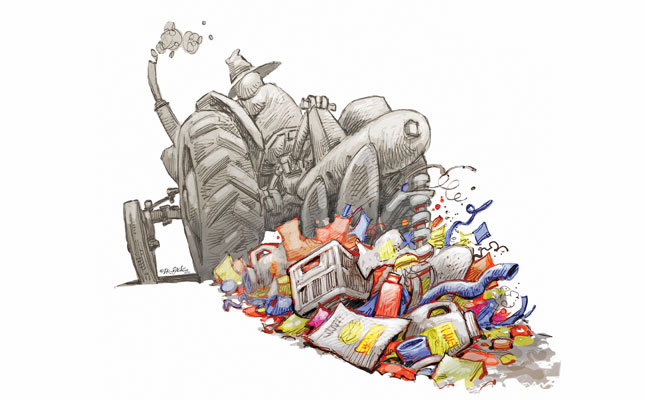
Plastics have become ubiquitous since their widespread introduction in the 1950s. Their properties, functionality, and relatively low cost have made them the polymers of choice for the manufacture of an extensive range of products, including those used in food value chains.
Modern agriculture employs a wide range of plastic products to help improve productivity. These include mulch and silage films; tunnel and greenhouse films and nets; irrigation tubes and driplines; fruit and plant protectors; non-woven protective textiles; coatings on fertilisers, pesticides and seeds; and bags, bottles, nets, ropes, lines, traps and enclosures.
Plastic products also help reduce food losses and waste, and maintain food’s nutritional qualities throughout value chains, thereby improving food security and reducing greenhouse gas emissions. Hygienic plastic packaging improves food safety by reducing contamination and premature decay.
Despite these benefits, plastics can also be problematic, causing pollution in both terrestrial and aquatic environments.
There are two main routes whereby plastic contaminants enter agricultural systems, namely leakage from non-agricultural sources such as windblown litter, or leakage from agricultural activities when agricultural plastic products are discarded or become damaged or degraded.
As global demand for plastic increases, leakage into the environment also increases, hindering efforts to mitigate environmental contamination. Once in the natural environment, plastic can cause harm in several ways.
As larger plastics begin to disintegrate and degrade, their effects begin to be exerted at cellular level, affecting individual organisms and also, potentially, entire ecosystems. Microplastics (smaller than 5mm in size) are thought to present specific risks to animal health.
Mulching film
Conventional, non-biodegradable plastic mulching film inhibits weed growth, reduces evaporation from the soil, and decreases run- off due to rainfall. However, mulching film can leave large quantities of plastic in the soil.
A number of interventions and alternatives have been assessed in an effort to deliver similar benefits while reducing the adverse impacts of non-biodegradable mulching film.
These include the following:
- Adopting mulching practices using organic materials or cover crops to avoid the use of plastics. Although these may appear costly, savings in inputs, long-term improvement of the soil, maintenance of yields, and access to premium markets could drive change in farming practices.
- Shifting to biodegradable film, which would avoid the need for retrieval and end-of-life management.
- Increasing film strength and tear-resistance to improve retrievability from the soil after the harvest.
- In the case of certain crops, introducing reusable mulching film that can be used over many growing seasons.
- Employing product labelling. This could provide usage information to farmers and be a potential mechanism to provide traceability through the plastics and waste management supply chain.
- Implementing collection schemes linked to mandatory extended producer responsibility (EPR). This would make it easier for role players in the supply chain to adopt sound environmental management of used films.
- Launching incentives and ensuring cross-compliance to encourage environmentally responsible behaviour.
- Redesigning equipment to retrieve used films, which would reduce the amount of plastic in the soil.
- Restructuring business models. This could include changing from merely supplying the product to providing an all-encompassing service that includes supply, application, maintenance, retrieval and end-of-life management, thereby improving the effectiveness of mulching and reducing plastic leakage.
Irrigation drip tape
Irrigation drip tape is a thin plastic tube with apertures inserted along its length during manufacture. It is generally used in conjunction with mulching film for a single planting season and retrieved after the harvest. Drip tape improves water-use efficiency and conserves water resources by providing water directly to the plants.
Some alternatives to drip tape include:
- Changing to an efficient and more permanent irrigation system, such as hydroponics.
Increasing the strength of the tape. This would reduce the risk of damage during use and retrieval, and enable it to be reused over a number of seasons. - Redesigning drip tape to improve its recyclability by constructing all its components from the same polymer.
Tree guards and shelters
Tree guards and shelters are semi-rigid tubes that are wrapped around the base of newly planted tree saplings to help them become established. They prevent damage by grazing animals, reduce competition with weeds, and create a protective microclimate.
Damage during use and photodegradation eventually cause the shelters and guards to fragment and possibly degrade into microplastics.
Possible alternatives include:
- Fencing areas with newly planted saplings to reduce or avoid the use of tree shelters.
Redesigning the product by changing its polymer composition and thickness to increase its lifespan or promote reuse. - Redesigning shelters to be fully biodegradable. This would mitigate the effects of plastic fragments entering the soil.
- Increasing sapling density to avoid the use of tree guards in areas where pressure from grazing animals and rodents is not excessive. This would result in more saplings perishing, but the remainder would grow to maturity.
Ear tags
Ear tags for livestock are made of hard plastic and may include an embedded radio-frequency identification device. They can be broken or lost, which may lead to animals ingesting them.
Alternatives to ear tags include:
- Adopting substitute marking systems such as injectable transponders.
- Recycling ear tags that are no longer in use.
- Introducing an incentive scheme that encourages farmers to collect broken and lost ear tags from their lands.
Greenhouse Films
Greenhouse films are highly engineered plastic products that improve yield, provide longer productive seasons, and result in lower pesticide and water usage. Designed to be used for a number of years, they eventually degrade.
Alternatives include the following:
- Replacing them with durable alternatives such as silica glass. These can be more costly, however.
- Implementing mandatory EPR schemes for collecting and recycling end-of-life film. This should drive investment in improved product design, which could increase the opportunity for closed-loop material recycling.
Empty pesticide containers
Discarded pesticide containers have long been recognised as a potential hazard to public health and the environment due to the nature of their residual contents.
Some alternatives and interventions include:
- Banning the use of small-dose sachets and phasing out non-recyclable packaging.
Practising the triple rinse and puncturing method to improve the recyclability of empty containers. - Introducing smart labelling and tacking to identify counterfeit pesticides and track containers through distribution channels.
- Implementing incentive schemes to encourage the return of empty containers.
- Introducing sprayer services, thus avoiding the need for each farmer to apply pesticide individually. In a community of small-scale farmers, for example, one farmer could be trained and equipped to provide a pesticide spraying service to neighbours.
The views expressed in our weekly opinion piece do not necessarily reflect those of Farmer’s Weekly.
This is an edited excerpt from the Food and Agriculture Organization of the United Nations’ report titled ‘An assessment of agricultural plastics and their sustainability: A call for action’, published in 2021.










